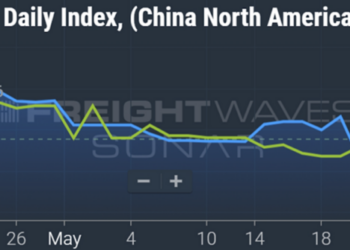Target joins the subscription club
Image: FWTV
On Monday’s episode of The Stockout, Grace Sharkey and I discussed last week’s announcement that Target is launching a subscription-based fast delivery service. For an introductory price of $49 a year (rising to $99 a year starting in May), customers receive free two-day shipping and free same-day delivery on orders over $35. The company’s ability to offer such speedy deliveries is made possible by its recent investments in local sortation and fulfillment centers. I get it — retail subscription services drive sales and loyalty. One of the stats that stuck with me from the Federal Trade Commission lawsuit against Amazon is that Amazon Prime subscribers buy four times as much as Amazon customers who are not subscribed to Prime (an average of $2,000 a year versus $500 for nonsubscribers). Still, Target Circle 360 seems like a competitive response to avoid market share loss to Walmart Plus, which offers a wider selection of grocery items, discounted gasoline and Paramount streaming with its fast delivery subscription. I expect Target Circle 360 to primarily serve the purpose of retaining existing Target customers by offering them a competitive level of convenience, but I, for the time being, struggle to see why the subscription would win the retailer conquest business.
Check out Monday’s The Stockout show here, which discussed this topic, or catch up with the full playlist here.
No signs of the big three ocean issues (Red Sea/Panama/ILA) going away soon
While nothing like mid-2021 to mid-2022, “healthy” ocean rates are encouraging container ship lines to keep capacity deployed. Chart: SONAR.
On Thursday, global logistics company Flexport hosted a webinar featuring a few members of its ocean procurement team. Here are some takeaways:
Carriers are publishing updates to their sailing schedules that assume longer routes around the Cape of Good Hope are the new normal. For instance, CMA CGM said no additional vessels bound for North America will transit the Red Sea.
Panama Canal transits per day are rising from 24 vessels currently to 27 on March 25. But 36 vessels a day is normal, and, based on the lack of rain in the forecast, water levels are expected to recede from an already-low level.
The International Longshoremen’s Association (ILA) contract expires Sept. 30, and local chapters need to have their issues resolved by May 17. If there is a strike/lockout, ships can’t divert to another port because other unions will refuse to unload those vessels and there’s not enough capacity at the U.S. West Coast and Canadian ports anyway.
Currently, 88% of trans-Pacific capacity is deployed, which is expected to rise to 98% in April. Healthy rates are encouraging carriers to keep high percentages of capacity deployed.
Van and reefer tender rejection rates fall in March
Dry van and reefer tender rejection rates are shown in white and green, respectively. Chart: SONAR.
The freight market was certainly weak in February, and most of the SONAR clients I talked to on the market largely attributed that to seasonality since that is so typical of February. But now we are roughly halfway through March, the make-or-break month for carriers’ first quarter, and when the freight market typically improves. This month, the tender rejection rate for dry van freight has fallen from an average of 4.6% in February to 3.5% currently, while the reefer tender rejection rate has fallen from a 6.9% February average to 4.8%. Dry van tender volume has only improved moderately since February — dry van volume month to date is up 1.6% from the February averages. Meanwhile, reefer volume is down 3.5% month to date from the February average. That suggests there remains plenty of capacity in the market to absorb the incremental volume. The flatbed sector is the exception to those trends which reflects the kickoff of construction season in the Northern states — flatbed tender rejections have surged to 18.9%, from an 11.7% average in February.
SEC won’t require scope 3 emissions reporting
FreightWaves’ John Kingston wrote up the Securities and Exchange Commission’s ruling last week. In short, the SEC will require most companies to report their scope 1 and scope 2 greenhouse gas emissions, but not scope 3. Scope 3 emissions are those from suppliers that are two steps away from the reporting company in the supply chain — in other words, suppliers that do not deal directly with the reporting company.
According to Lindsay Azim, director at supply chain consultant Gartner Inc., the ruling was not a surprise given the enormous burden of reporting scope 3 emissions. There is also the question of whether scope 3 falls outside the SEC’s jurisdiction because it would mandate public disclosures from privately held companies. While unsurprising to some, the SEC’s decision is a big deal, in particular for the consumer packaged goods industry because many of the publicly traded companies in that sector have announced ambitious targets to reduce greenhouse gas emissions. In addition to Kingston’s article, I recommend reading this Just Food article, which describes many of the largest CPG companies’ emissions targets.
The post Do we really need another retail subscription service? appeared first on FreightWaves.














